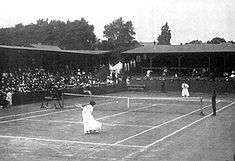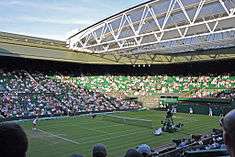All England Lawn Tennis and Croquet Club

The All England Lawn Tennis and Croquet Club,[1] also known as the All-England Club,[2] based at Church Road, Wimbledon, London, England, is a private members' club. It is best known as the venue for the Wimbledon Championships, the only Grand Slam tennis event still held on grass. Initially an amateur event that occupied club members and their friends for a few days each summer, the championships have become far more prominent than the club itself. However, it still operates as a members' tennis club, with many courts in use all year round.
The club has 375 full members, about 100 temporary playing members, and a number of honorary members, including past Wimbledon singles champions and people who have rendered distinguished service to the game. To become a full or temporary member, an applicant must obtain letters of support from four existing full members, two of whom must have known the applicant for at least three years. The name is then added to the Candidates' List. Honorary Members are elected from time to time by the club's Committee. Membership carries with it the right to purchase two tickets for each day of the Wimbledon Championships.[3]
The patron of the club is Queen Elizabeth II, and the President is The Duke of Kent.[4]
History
The Club was founded by six gentlemen[lower-alpha 1] at the offices of The Field on 23 July 1868 at the height of a croquet craze[5] as the All England Croquet Club, and held its first croquet competition in 1870. Its original ground was situated off Worple Road, Wimbledon. Croquet was very popular there until the then-infant sport of lawn tennis (a game introduced by Major Walter Clopton Wingfield a year or so prior, and originally called Sphairistikè) was introduced in 1875,[6] when one lawn was set aside for this purpose.[7] The first tennis Gentlemen's Championship in Singles was held in July 1877, when the Club changed its name to The All England Croquet and Lawn Tennis Club. That year at Wimbledon service was underarm. The champion, Spencer Gore, opined that "Lawn tennis will never rank among our great games."[8] In 1878 the height of the net was altered to 4 feet 9 inches (1.45 m) at the posts and 3 feet (0.91 m) at the centre.[9] In 1882, croquet was dropped from the name, as tennis had become the main activity of the Club. But in 1899 it was restored to the Club's name for sentimental reasons, and the Club's name became The All England Lawn Tennis and Croquet Club.
In 1884, the Club added Ladies' Singles and Gentlemen's Doubles, and then in 1913 Ladies' Doubles and Mixed Doubles.[10] For the 1908 Summer Olympics, the venue hosted the Grass Courts tennis events.[11] The early Club colours were found to be almost identical to those of the Royal Marines, so they were changed in 1909 to the present Club colours of dark green and purple.[12] The popularity of Frenchwoman Suzanne Lenglen was largely responsible for forcing the Club to move to larger grounds at its present site in Church Road, Wimbledon, in 1922,[13] where its first Championship was "plagued by rain each day".[14]
The current Centre Court dates from that year. It has been improved and extended on several occasions. Most recently a sliding roof was added in time for the 2009 Championships. In 1924 the old No. 1 Court opened on the west side of Centre Court. During World War II The Championships were suspended but the Club remained open with a much smaller staff, and was used for fire and ambulance services, British Home Guard, and a decontamination unit, and troops stationed nearby drilled on the main concourse. At 5:20 p.m. on October 11, 1940, five 500 pound German bombs struck the grounds, demolishing 1,200 seats in Centre Court.[15] The old No. 1 Court was replaced with the current No. 1 Court in 1997, and the Broadcast Centre was built at the same time. Shortly afterwards, the Millennium Building, which houses facilities for players, press, officials and members, was built on the site of the old No. 1 Court.
The Church Road site initially extended only as far north as Centre Court. In 1967 the All England Club purchased 11 acres (4.5 ha) to the north. This was leased to the New Zealand Sports and Social Club and became known as Aorangi Park (Aorangi means "Cloud Piercer", and is the Māori part of Aoraki/Mount Cook; "Aorangi" is the standard Māori spelling and "Aoraki" is used in the Māori dialect in the vicinity of the mountain). It is most commonly known as 'Henman Hill' because of the popularity of former British tennis player, Tim Henman. Initially the only use that the All England Club itself made of this new land was for car parking during The Championships, but in 1981 the New Zealanders' lease was terminated, and the Club has developed most of the area for its own purposes.
The All England Club, through its subsidiary The All England Lawn Tennis Ground plc, issues debentures to tennis fans every five years to raise funds for capital expenditure.[16] The original debentures were issued in 1920. Each debenture provides a pair of tickets for each day of the tournament for five years. Only debenture holders are legally permitted to sell on their tickets to third parties.
The Club was the venue for the tennis event at the 2012 Summer Olympics.[17][18]
Facilities
The Club currently has 19 tournament grass courts, eight American clay courts, two acrylic courts and five indoor courts. There are also 22 Aorangi Park grass courts, which serve as competitors' practice courts before and during The Championships. The grass courts can be used from May until September. The grass has been cut to 8 mm since 1995, and 100% perennial rye grass has been used for its strength since 2001 (prior to that, it was 70% perennial rye and 30% creeping red fescue).[19][20] The courts are renovated in September, using nine tons of grass seed annually.[21]
The largest court is Centre Court, which usually hosts the finals of the main singles and doubles events at The Championships. The quotation above the players' entrance to Centre Court is an extract from the poem "If—", by Rudyard Kipling, which reads: "If you can meet with triumph and disaster and treat those two impostors just the same." This court also served as the main venue for the tennis events at the 2012 Summer Olympics. Initially, the courts were arranged in such a way that the principal court was situated in the middle with the others arranged around it; hence the title "Centre Court".[22]
The present Centre Court, built in 1922 upon the move of the Club, was not actually in the centre at the time it was built, but as new courts were added in later years it became a more accurate description. It currently seats 15,000 – expanded from 14,000 following redevelopment in 2007–08 (spatially, the expansion is greater than those numbers imply, as seats have been widened), and (as of 2009) is the fourth-largest tennis stadium in the world.[23] The Club installed a retractable roof on Centre Court which was completed in May 2009. It is a 'folding concertina' made of 5,200 square metres of a translucent waterproof fabric that allows natural light to reach the grass, and opens/closes in under 10 minutes.[24] Redevelopment work commenced in 2006 and Centre Court had no roof at all in place for the duration of the 2007 Championships.
The other 'show court' is No. 1 Court, built in 1997, which holds around 11,500 people and occasionally plays host to Davis Cup matches (Centre Court usually being reserved for the Wimbledon Championships). This is to be fitted with a retractable roof similar to Centre Court in time for the 2019 Championships.[25]
A new No. 2 Court with 4,000 seats was first used at the 2009 Championships. The old No. 2 Court was renamed No. 3 Court in 2009, and was rebuilt after the 2009 Championships. The grounds are set to undergo major renovation in the coming years.[26]
The Club also houses the Wimbledon Lawn Tennis Museum.
The Championships
Among the features that differentiate The Championships from the other Grand Slams are that they are played on grass courts, they require the players to wear white, and they schedule a day off on the middle Sunday of the tournament (though sometimes — such as in 2004 and 2016 — poor weather has meant play has needed to take place).[27] The winner of the Gentlemen's singles at The Championships receives a gold trophy inscribed with the words: "The All England Lawn Tennis Club Single Handed Champion of the World".[28]
The Championships attract attendance of around 450,000 people. Ninety per cent of the financial surplus that the Club generates from running The Championships is used to develop tennis in Great Britain; between 1998–2008 the surplus ranged from £25–33 million per year.[29] The Championships are run by a Committee of Management that consists of 12 club members and seven nominees of The Lawn Tennis Association (LTA). The 2009 Committee included the following Club members: Timothy Dewe Phillips CBE (Chairman), PGH Brook, JS Dunningham, RM Gradon, IL Hewitt, DA Jevans, AS Jones CBE, MA King, TH Henman OBE, GM Newton, JC Tatum, and KF Weatherley.[30][31]
In 2003, a long-standing tradition of Centre Court players bowing or curtseying to the Royal Box was discontinued by order of the Duke of Kent, President of the Club since 1969, who deemed it an anachronism in modern times. The only exception would be if the Queen or the Prince of Wales were to attend.[32] Andy Murray and Jarkko Nieminen elected to bow when the Queen visited The Championships for their 2010 2nd Round match, as did Roger Federer and Fabio Fognini at their 2nd round match, watched by the Prince of Wales, in 2012.
Racism and sexism controversies
Black players were not allowed to play at the club until 1951, and Jews were not admitted until 1952.[33] According to Angela Buxton, the Jewish former British Wimbledon doubles champion, it also has led to her exclusion.[34] Buxton said in 2004, reflecting on the fact that the All England Club, almost 50 years after Buxton's 1956 Wimbledon triumph with Althea Gibson, had still not invited Buxton to join: "I think the anti-Semitism is still there. The mere fact that I'm not a member is a full sentence that speaks for itself." Buxton told New York Post reporter Marc Berman that she had been on the "waiting list" since she applied in the 1950s.[35] "I wish it still wasn't such an elite sport," Buxton told Berman. "I wish we could bring it down to a common baseline. It's going that way. It's still not there."[36][37][38]
In 2006, Phillips said that paying men and women equal prize money at The Championships was something they "fundamentally don’t think would be fair on the men." (due to men playing best-of-five sets, and women only best-of-three). The championships accepted equal prize money the following year.[39]
See also
- The Championships, Wimbledon
- The Wimbledon Effect
- Wimbledon Manor House
- Queen's Club – London's second most famous tennis club
- History of tennis
- Lawn Tennis Association
Notes
- ↑ The gentlemen were John H. Walsh, Captain R.F. Dalton, John Hinde Hale, Rev. A. Law, S.H. Clarke Maddock and Walter Jones Whitmore. Walsh, the magazine's editor, was the chairman of the meeting. Whitmore and Maddock were appointed honorary secretary and treasurer respectively.
References
- ↑ "About the AELTC". www.wimbledon.com. Retrieved 2015-07-08.
- ↑ Andreff, Wladimire, and Szymański, Stefan, "Handbook on the economics of sport", Edward Elgar Publishing (2006), ISBN 1-84376-608-6, ISBN 978-1-84376-608-7
- ↑ "The All England Lawn Tennis Club," Wimbledon.org, accessed 29 June 2009
- ↑ "The All England Lawn Tennis Club" Wimbledon.org, accessed 15 July 2009
- ↑ "Anyone for a game of sphairistiké?" 41, The Northern Echo, 27 June 2009, accessed 8 July 2009
- ↑ "A Brief History of Wimbledon", The Times of India, 19 June 2008, accessed 8 July 2009
- ↑ Albert, Jim; Ruud, H Koning (2007), Statistical Thinking in Sports, CRC Press, p. 217, ISBN 978-1-58488-868-0.
- ↑ Siddons, Larry (21 June 1986), A Rich History to Celebrate, The Free-Lance Star, retrieved 8 July 2009.
- ↑ Wrangham Wilberforce, Herbert William (1908), Hillyard "Lawn tennis", G. Bell, p. 5.
- ↑ "About Wimbledon Championships", China Radio International English, 17 June 2005, accessed 8 July 2009.
- ↑ Summer Olympics official report (PDF), LA84 Foundation, 1908, p. 209.
- ↑ "Club Colours", Behind the scenes, About, Wimbledon, retrieved 14 July 2009.
- ↑ "Women's fashion hits the courts", BBC, 19 June 1998, accessed 8 July 2009
- ↑ Worrall, Simon, "Mice and Mist and Mirthlessnis Mix at the All England Lawn Tennis and Croquet Club", Salon, 7 August 1998, accessed 7 September 2009
- ↑ About Wimbledon – History – Wartime Wimbledon," Wimbledon.org, accessed 7 October 2009
- ↑ "About Wimbledon Debentures," Archived 23 July 2010 at the Wayback Machine. The All England Lawn Tennis Ground, accessed 29 June 2009
- ↑ "Olympics", About, Wimbledon.
- ↑ Wimbledon, London2012, retrieved 29 September 2010.
- ↑ Bletchly, Rachael (24 June 2007), The Wonders of Wimbledon Fortnight, People, retrieved 8 July 2009.
- ↑ "Grass Courts", The Championships (PDF), Wimbledon, 2009, retrieved 15 July 2009.
- ↑ "Grass courts". The Championships, Wimbledon 2012. AELTC, IBM Corp. 2012. Retrieved 11 June 2012.
- ↑ "The Beginning", About, Wimbledon, 2009, retrieved 7 October 2009.
- ↑ "The Championships, Wimbledon", Bleacher Report, 29 June 2009, accessed 8 July 2009
- ↑ "How the roof works", Behind the scenes, About Wimbledon, Wimbledon, 2009, retrieved 29 June 2009.
- ↑ "Wimbledon prize money up 40% and roof planned for Court One". BBC Sport. BBC. 23 April 2013. Retrieved 23 April 2013.
- ↑ Ensor, Josie (23 April 2013). "Wimbledon to see one of the biggest revamps in its history". The Daily Telegraph. London.
- ↑ Fendrich, Howard (21 June 2009), Like Federer, Venus seeks sixth Wimbledon title, The Canadian Press, retrieved 8 July 2009.
- ↑ Rigby, Christopher (2004), 1000 Facts on Sport, Miles Kelly Publishing, p. 136, ISBN 978-1-84236-397-3
- ↑ "Finance", The Championships (PDF), Wimbledon, 2009, retrieved 15 July 2009.
- ↑ "The All England Lawn Tennis Club", About, Wimbledon, 2009, retrieved 7 August 2009
- ↑ "Leftovers: All England, all the time"
- ↑ Parsons, John; Davies, Caroline (30 April 2003). "Wimbledon abandons the Royal Box curtsey". The Daily Telegraph. London. Retrieved 8 July 2009..
- ↑ Siriginia, Saraswathi, "Wimbledon Rewind: How Angela Buxton and Althea Gibson Broke Barriers in 1956," Bleacher Report, 16 June 2009, accessed 29 June 2009
- ↑ Hoye, Russell, Smith, Aaron, Nicholson, Natthew, Stewart, Bob, and Westerbeek, Hans, "Sport Management-principles and applications: Case Study: The All England Lawn Tennis and Croquet Club and the Wimbledon Tennis Championship", p. 197, Butterworth-Heinemann (2009), ISBN 0-7506-8755-X, ISBN 978-0-7506-8755-3
- ↑ Schoenfeld, Bruce, "The Match: Althea Gibson & Angela Buxton: How Two Outsiders—One Black, the Other Jewish—Forged a Friendship and Made Sports History" (2004), pp. 279–80, Amistad, ISBN 0-06-052652-1, ISBN 978-0-06-052652-8, accessed 29 June 2009
- ↑ Buxton, Angela, Jews in Sports, retrieved 29 June 2009
- ↑ Slater, Robert (2005), Great Jews in Sports, Jonathan David Publishers, ISBN 978-0-8246-0453-0.
- ↑ Giles, Juanita (26 February 2009), No Jews allowed: UAE bows to 'neighborhood' pressure, The Hook, retrieved 29 June 2009.
- ↑ "Wimbledon serves up equal pay for women" Archived 7 June 2011 at the Wayback Machine., Daily Times, 23 February 2007, accessed 8 July 2009
External links
| Wikimedia Commons has media related to All England Club. |
- Club page on the Wimbledon Championships site
- "Wimbledon: Facts, Figures, and Fun," by Cameron Brown
Coordinates: 51°26′1.48″N 0°12′50.63″W / 51.4337444°N 0.2140639°W

.jpg)



